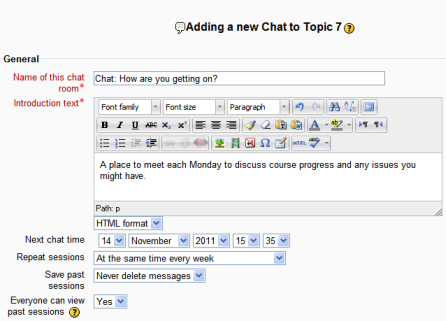Chat administration
Adding a Chat to your course
- With the editing turned on,in the section you wish to add your chat, click the "Add an activity or resource" link (or, if not present, the "Add an activity" drop down menu )and choose Chat
Course settings
Name of this chat room
- Whatever you type here will form the link learners click on to enter the chat so it is helpful to give it a name that suggests its purpose - for example "Student council discussion" or "Field trip planning meeting".
Introduction text
Type the description of the chat here. Include precise instructions for students regarding the subject of the chat. There is also an option to display the chat description on the course page below the link to the activity.
Next chat time
- The day and hour of the next chat session. This will appear in the calendar so students know the schedule but it doesn't stop them accessing the chatroom at any other time.
- If you don't want them in the chatroom at other times, then hide it (with the eye icon) or use Conditional activities to restrict access.
- If you don't wish to schedule chat times then ignore this and choose from the next settings.
Note:For courses involving users across different time zones, it is useful to know that the time you set here will be adjusted to match the time zone of the user viewing it.
Repeat sessions
- There are four options for scheduling future chat sessions:
- Don't publish any chat times- there are no set times and students are welcome to chat at any time.
- No repeats - publish the specified time only- only the Next chat time will be published. This could be used to schedule special events or meetings or simply to help learners identify a common time in which they can expect to find other learners in the chat room.
- At the same time every day- Daily chats are useful for scheduling daily office hours or work sessions with learners.
- At the same time every week--This setting will schedule a chat for the same day and time every week, which could be useful for instance for meeting and reviewing key ideas and questions related to the week’s content/assessment.
Save past sessions
- Choose from the dropdown how many days to save - or save everything by selecting Never delete messages
- If you have any concerns about discussions that might take place in your chat room, you may want to keep transcripts te check the suitablility of what is discussed. If your learners are using the chatroom to collaborate on a group project you won't want to delete the messages until the project is complete.
Everyone can view past sessions
- Decide here whether or not allow everyone to view past chat sessions. (Teachers can always view past sessions)
Other settings
There are the usual Common module settings and - if admin has enabled them - the Restrict access settings Conditional activities.
Locally assigned roles
- In Settings > Chat administration > Locally assigned roles selected users can be given additional roles in the activity, such as the capability to delete chat logs.
- Role permissions for the activity can be changed in Settings > Chat administration > Permissions.
Site administration settings
The chat module has additional settings which may be changed by an administrator in Settings > Site administration > Plugins > Activity modules > Chat. They depend on the chat method which has been selected:
Ajax
- This is the default method. It works everywhere but if many people are chatting it can put a large load on the server. Its particular settings are:
- Refresh user list - choose the number of seconds after which the user list is refreshed
- Disconnect timeout - choose the number of seconds after which we detect a user has disconnected.
Normal method
- The particular settings for this method are:
- Refresh room - choose the number of seconds after which the room is refreshed
- Update method - choose how to update the chatroom - "Keep alive" or "Stream" strategy. Stream works better but your sever might not support it.
Chat server daemon
- A daemon is a program that runs all the time in the background. In this case it's a PHP script, listening to a particular port on your server, accepting and giving out chat information.If you intend to use the chat activity a lot, then you should consider using a chat server daemon to reduce server load.Its particular settings are:
- Server name
- Server IP address
- Server port
- Max users
Then you need to start the chat daemon script from the command line:
cd moodle/mod/chat php chatd.php --start &

